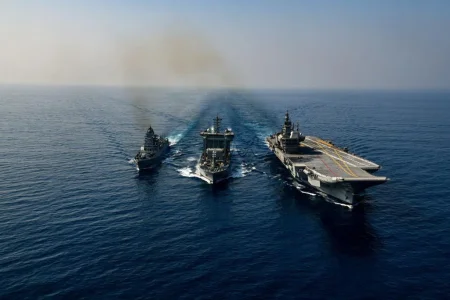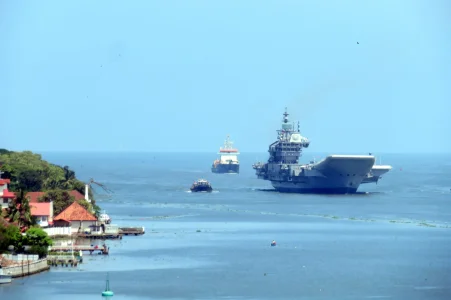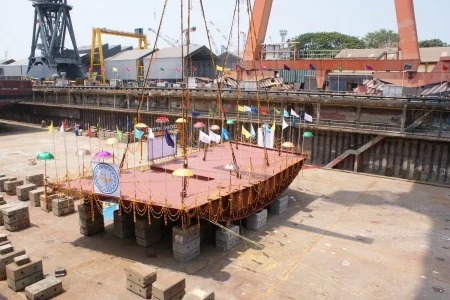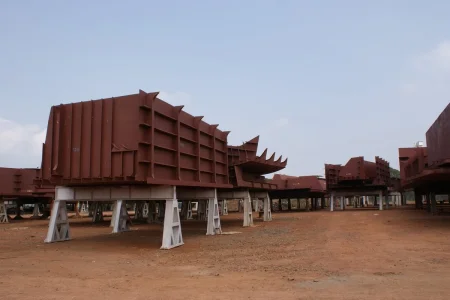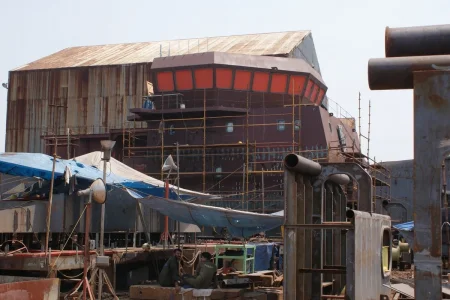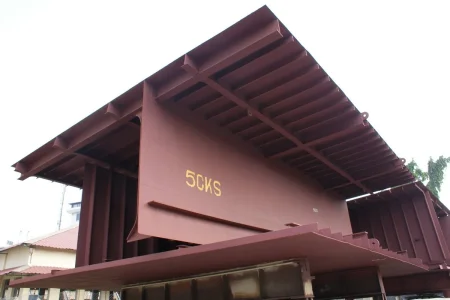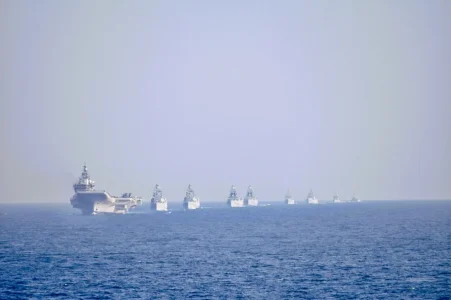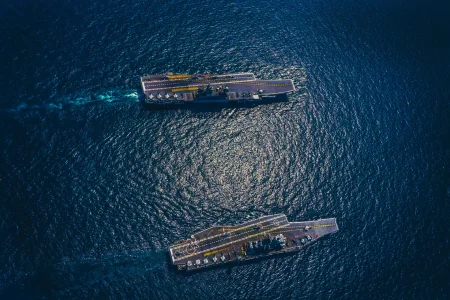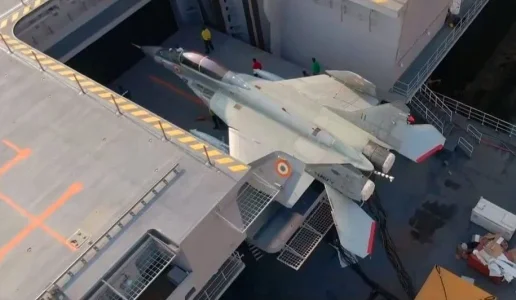You are using an out of date browser. It may not display this or other websites correctly.
You should upgrade or use an alternative browser.
You should upgrade or use an alternative browser.
INS Vikrant (1 Viewer)
- Thread starter darkflame
- Start date
More options
Who Replied?- Joined
- Jun 30, 2024
- Messages
- 1,239
- Likes
- 2,847
- Joined
- Jun 27, 2024
- Messages
- 2,998
- Likes
- 10,711
The Keel of the India’s first Indigenous Aircraft Carrier (IAC) was laid on 28th February 2009 at the Cochin Shipyard in Kochi.
It was scheduled to be completed by 2014. The carrier was floated out of dry dock in December 2011 and launched in August 2013.
Basin trials were completed in December 2020, and sea trials started in August 2021. Its commissioning ceremony was held on 2 September 2022.
It was scheduled to be completed by 2014. The carrier was floated out of dry dock in December 2011 and launched in August 2013.
Basin trials were completed in December 2020, and sea trials started in August 2021. Its commissioning ceremony was held on 2 September 2022.
- Joined
- Jun 27, 2024
- Messages
- 2,998
- Likes
- 10,711
Initial discussion on INS Vikrant at time of keel laying ceremony:
OP: @A.V
The ship has a length of 260 m and maximum breadth of 60 m. The ship will be propelled by two shafts, each coupled to two LM2500 Gas Turbines developing a total power of 80 MW, sufficient to attain speeds in excess of 28 knots. The ship has an endurance of around 8,000 NM and complement of 1600. The ship will have two take off runways and a landing strip with 3 arrester wires. It can carry a maximum of 30 aircraft with adequate hangarage capacity. The carrier is designed with a very high degree of automation for machinery operation, ship navigation and survivability.
The production of Indigenous Aircraft Carrier commenced in November 2006 and large numbers of blocks have already been fabricated, which are under erection. Major equipment to be installed in lower decks of the ship have been ordered. The ship is being constructed using high strength steel developed in-house with the help of DRDO and SAIL. Long Range Surface to Air Missile (LR SAM) system with Multi-Function Radar (MFR) and Close- In Weapon System (CIWS) is envisaged for the carrier. The ship will be equipped with the most modern C/D band early Air Warning Radar, V/UHF Tactical Air Navigational and Direction Finding systems. The carrier would also be having jamming capabilities over the expected Electro Magnetic (EM) environment, along with Carrier Control Approach Radars to aid air operations. Integration of all weapon systems onboard the carrier would be through an indigenous Combat Management System (CMS).The ship’s integration with Navy’s Network Centric Operations would provide force multiplication.
Design of this prestigious ship has been undertaken by the Directorate of Naval Design (DND) which has an experience of over 40 years in successfully designing 17 different classes of warships, to which around 90 ships have already been built within the country. It is also pertinent to mention that DND is the only government organisation in the world today undertaking indigenous design of warships. Delhi class destroyers are the biggest warships built so far by indigenous design. These ships are operating successfully over last 10 years and have demonstrated their design superiority when INS Delhi withstood extremely adverse weather conditions and high sea states while encountering typhoons during the ship’s passage in the South China Sea in 1995.
M/s CSL was chosen for building Indigenous Aircraft Carrier, based on its modern infrastructural facilities. Though this is the maiden venture for CSL in warship construction, the shipyard has been involved in commercial shipbuilding for the past three decades. In order to optimize on build period of IAC, CSL has been provided with over Rs 200 Crores to augment infrastructure in areas such as large cranes, workshops, heavy duty machinery etc.
The ship construction is planned in two phases. The First phase covers work up to first launch in end 2010. The second phase would cover all balance work till delivery of the ship to the Navy in end 2014. Assistance for propulsion system integration and aviation aspects have been taken from M/s Fincantieri of Italy and M/s NDB of Russia respectively.
OP: @A.V
- Joined
- Jun 27, 2024
- Messages
- 2,998
- Likes
- 10,711
2010 Interview with then Mr. Jitendran, then Chairman & MD of Cochin Shipyard.
INTERVIEW: - M. JITENDRAN, CHAIRMAN & MD, COCHIN SHIPYARD
Commodore M. Jitendran was taking a chance when he took premature retirement from the Indian Navy and joined the Cochin Shipyard. A postgraduate in naval architecture from IIT Kharagpur and St Petersburg, he is a fellow of the Royal Institution of Naval Architects, London.
Despite the global financial meltdown, the last fiscal saw the yard’s turnover crossing Rs 1,200 crore, a huge jump from Rs 228 crore in 2003-2004. The yard also delivered two of India’s largest double hull Aframax tankers. In an interview with THE WEEK, Jitendran spoke about the challenges of the Indigenous Aircraft Carrier (IAC) project. Excerpts:
What is the status of the IAC?
The work is going on in full swing. We have completed more than 70 per cent of the fabrication of hull blocks. The concept design for the carrier with approximately 37,500 metric tonnes displacement, defining the overall ship dimensions, evolution of hull form, general arrangement drawings, structure, stability, weight and space analysis and hydrodynamic model tests have been completed.
The project is behind schedule.
Yes, we are three months behind schedule. We had to deal with the non-availability of high-grade steel. The issue has been sorted out and we expect to bridge the delay in the coming months. We will deliver the carrier on time.
A Parliament committee said that in comparison to the US Nimitz class and INS Vikramaditya, the IAC stands nowhere in terms of dimension, displacement and aircraft carrying capacity.
We are working on an evolving design. The Navy has shared only the basic design with us. They are constantly working on the features of the carrier to make it the best of its size in the world.
For the last two decades Cochin Shipyard has been working on INS Viraat. Has that helped?
We are proud of our regular work on INS Viraat. We have performed major overhauls on her. It has given us deep insight on carriers and has honed skills of our engineers.
What kind of competition are you facing from foreign shipyards?
There is immense competition from yards in the Far East and south-east Asia for commercial shipbuilding. Their cost and schedules are very challenging. So far, we have been able to match their performance and win orders globally. The shipbuilding industry in India has been ignored and there is very little awareness of its potential. We are 10 to 20 years behind in shipyard planning and infrastructure compared to shipbuilding countries like Japan.
What are your plans to enhance the yard?
We have planned a Small Ship Division project. It is essentially to create additional capacity for undertaking commercial ship construction concurrently with the IAC project. The yard also plans to diversify into niche hi-tech products. Our endeavour is to become an internationally competitive yard and to make India a dominant shipbuilding and ship-repair centre in the region.
India’s biggest ship owner, the Shipping Corporation of India, has signed an MoU with the yard. What are the advantages?
It is a win-win situation. The joint venture was a way of dealing with the global situation. It will help us to build ships at economical prices and plan a capacity expansion. It would guarantee business for both companies for several years.
We will deliver IAC on time
INTERVIEW: - M. JITENDRAN, CHAIRMAN & MD, COCHIN SHIPYARD
Commodore M. Jitendran was taking a chance when he took premature retirement from the Indian Navy and joined the Cochin Shipyard. A postgraduate in naval architecture from IIT Kharagpur and St Petersburg, he is a fellow of the Royal Institution of Naval Architects, London.
Despite the global financial meltdown, the last fiscal saw the yard’s turnover crossing Rs 1,200 crore, a huge jump from Rs 228 crore in 2003-2004. The yard also delivered two of India’s largest double hull Aframax tankers. In an interview with THE WEEK, Jitendran spoke about the challenges of the Indigenous Aircraft Carrier (IAC) project. Excerpts:
What is the status of the IAC?
The work is going on in full swing. We have completed more than 70 per cent of the fabrication of hull blocks. The concept design for the carrier with approximately 37,500 metric tonnes displacement, defining the overall ship dimensions, evolution of hull form, general arrangement drawings, structure, stability, weight and space analysis and hydrodynamic model tests have been completed.
The project is behind schedule.
Yes, we are three months behind schedule. We had to deal with the non-availability of high-grade steel. The issue has been sorted out and we expect to bridge the delay in the coming months. We will deliver the carrier on time.
A Parliament committee said that in comparison to the US Nimitz class and INS Vikramaditya, the IAC stands nowhere in terms of dimension, displacement and aircraft carrying capacity.
We are working on an evolving design. The Navy has shared only the basic design with us. They are constantly working on the features of the carrier to make it the best of its size in the world.
For the last two decades Cochin Shipyard has been working on INS Viraat. Has that helped?
We are proud of our regular work on INS Viraat. We have performed major overhauls on her. It has given us deep insight on carriers and has honed skills of our engineers.
What kind of competition are you facing from foreign shipyards?
There is immense competition from yards in the Far East and south-east Asia for commercial shipbuilding. Their cost and schedules are very challenging. So far, we have been able to match their performance and win orders globally. The shipbuilding industry in India has been ignored and there is very little awareness of its potential. We are 10 to 20 years behind in shipyard planning and infrastructure compared to shipbuilding countries like Japan.
What are your plans to enhance the yard?
We have planned a Small Ship Division project. It is essentially to create additional capacity for undertaking commercial ship construction concurrently with the IAC project. The yard also plans to diversify into niche hi-tech products. Our endeavour is to become an internationally competitive yard and to make India a dominant shipbuilding and ship-repair centre in the region.
India’s biggest ship owner, the Shipping Corporation of India, has signed an MoU with the yard. What are the advantages?
It is a win-win situation. The joint venture was a way of dealing with the global situation. It will help us to build ships at economical prices and plan a capacity expansion. It would guarantee business for both companies for several years.
- Joined
- Jun 27, 2024
- Messages
- 2,998
- Likes
- 10,711
EXCLUSIVE: Naval Design Head’s Paper On Aircraft Carrier
February 10, 2010 / By Team Livefist
Cmde AK Khetan, Principle Director at the Department of Naval Design, has been closely associated with the Indiangenous Aircraft Carrier programme and was the project director during the crucial phase of design finalisation, equipment ordering and the contract signing with Cochin Shipyards for its construction. The following is the paper he presented earlier today at the National Maritime Foundation seminar on Aircraft Carriers in the 21st Century:
February 10, 2010 / By Team Livefist
Cmde AK Khetan, Principle Director at the Department of Naval Design, has been closely associated with the Indiangenous Aircraft Carrier programme and was the project director during the crucial phase of design finalisation, equipment ordering and the contract signing with Cochin Shipyards for its construction. The following is the paper he presented earlier today at the National Maritime Foundation seminar on Aircraft Carriers in the 21st Century:
1.1 Aircraft Carrier is considered to be the most versatile ship combining the role of a sophisticated warship with that of fighter aircraft. The first function of a carrier is obviously to deploy aircraft far from the home land. Depending on the country’s goal and maritime objectives, this deployment may be required under severe weather conditions, worldwide far from the home land, in peace as well as in war, and as promptly as possible.
1.2 The carrier is used for different missions, i.e. launched strikes against military and economic targets, naval and surface warfare, pre-strategic nuclear strikes against land and naval targets, protection of sea lanes and humanitarian aids. Aircraft carriers are also recognized show of country’s might for exercising influence on foreign policy.
1.3 These ships are indeed the pinnacle of design complexity and engineering marvel involving practically all facets of technology. Accordingly, these are also the costliest ships requiring versatile infrastructure for its construction, upkeep, maintenance and operation. Therefore, realization of an aircraft carrier necessitates strong technological base and huge financial commitments. It is because of this that only very few leading nations of the world operate aircraft carriers range of which is extensive from a 13,800 tonne STOVL Italian Garibaldi to an 1,05,000 tonneCTOL US Navy CVAN.
Full Article: https://www.livefistdefence.com/exclusive-naval-design-heads-paper-on/
1.2 The carrier is used for different missions, i.e. launched strikes against military and economic targets, naval and surface warfare, pre-strategic nuclear strikes against land and naval targets, protection of sea lanes and humanitarian aids. Aircraft carriers are also recognized show of country’s might for exercising influence on foreign policy.
1.3 These ships are indeed the pinnacle of design complexity and engineering marvel involving practically all facets of technology. Accordingly, these are also the costliest ships requiring versatile infrastructure for its construction, upkeep, maintenance and operation. Therefore, realization of an aircraft carrier necessitates strong technological base and huge financial commitments. It is because of this that only very few leading nations of the world operate aircraft carriers range of which is extensive from a 13,800 tonne STOVL Italian Garibaldi to an 1,05,000 tonneCTOL US Navy CVAN.
Full Article: https://www.livefistdefence.com/exclusive-naval-design-heads-paper-on/
View: https://www.youtube.com/live/lSDIqbWkilU?si=OZ5A8hZPmLenmaKZ
curtain raiser' presentation on the IAC by the IN from September 2022
Users who are viewing this thread
Total: 1 (members: 0, guests: 1)
Similar threads
- Replies
- 25
- Views
- 605
Latest Replies
-
Indian Railways
- infrabug
-
Operation Sindoor & Aftermath
- eastern_bhartiya
-
Jokes Thread
- Prasad
-
Gems of Congress
- liberalredditor
-
DRDO & PSUs
- shade2
-
Indo EU Relations
- shade2
-
Indian Special Forces
- COLDHEARTED AVIATOR
-
Op Sindoor: Memes and Psy-Ops Corner
- FalconSlayers
-
Highways and expressways
- infrabug

